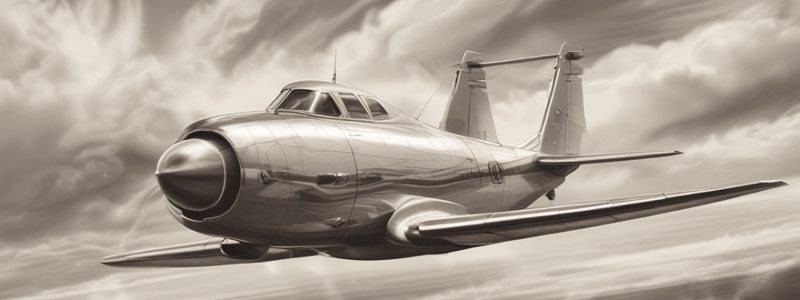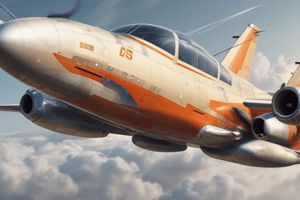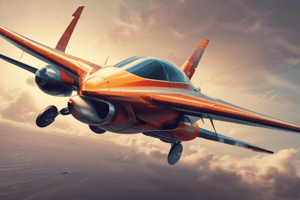Podcast
Questions and Answers
What is the primary purpose of thrust in an aircraft?
What is the primary purpose of thrust in an aircraft?
- To counteract the force of drag (correct)
- To generate lift
- To increase the airspeed
- To reduce the weight of the aircraft
Which type of drag is directly related to lift production?
Which type of drag is directly related to lift production?
- Induced drag (correct)
- Interference drag
- Skin friction
- Form drag
What is the result of increased induced drag due to increased weight?
What is the result of increased induced drag due to increased weight?
- A decrease in the angle of attack
- An increase in the angle of attack (correct)
- A decrease in the airspeed
- A decrease in the thrust
Why might an increase in weight lead to higher form drag?
Why might an increase in weight lead to higher form drag?
What is a consequence of increased weight on an aircraft's engine power settings?
What is a consequence of increased weight on an aircraft's engine power settings?
What is the primary component of parasite drag that is affected by weight?
What is the primary component of parasite drag that is affected by weight?
What is the relationship between weight and parasite drag?
What is the relationship between weight and parasite drag?
What is the result of increased weight on an aircraft's wingtip vortices?
What is the result of increased weight on an aircraft's wingtip vortices?
Why is it important to consider the distribution of weight in an aircraft?
Why is it important to consider the distribution of weight in an aircraft?
What is the ultimate consequence of increased induced drag?
What is the ultimate consequence of increased induced drag?
The total drag experienced by an aircraft is solely affected by its weight.
The total drag experienced by an aircraft is solely affected by its weight.
The lift-producing airfoil creates a pressure difference between the upper and lower surfaces, leading to the formation of wingtip vortices that reduce drag.
The lift-producing airfoil creates a pressure difference between the upper and lower surfaces, leading to the formation of wingtip vortices that reduce drag.
Parasite drag is directly related to lift production and has a straightforward relationship with weight.
Parasite drag is directly related to lift production and has a straightforward relationship with weight.
A lighter aircraft requires more thrust to achieve the same performance as a heavier one.
A lighter aircraft requires more thrust to achieve the same performance as a heavier one.
The influence of weight on drag can be examined through only one primary component: induced drag.
The influence of weight on drag can be examined through only one primary component: induced drag.
The distribution of weight does not play a role in an aircraft's drag.
The distribution of weight does not play a role in an aircraft's drag.
Induced drag arises because the wing creates a pressure difference between the upper and lower surfaces, leading to the formation of wingtip vortices that reduce lift.
Induced drag arises because the wing creates a pressure difference between the upper and lower surfaces, leading to the formation of wingtip vortices that reduce lift.
An increase in weight leads to a decrease in the angle of attack at a given airspeed.
An increase in weight leads to a decrease in the angle of attack at a given airspeed.
The relationship between weight and parasite drag is always linear.
The relationship between weight and parasite drag is always linear.
Thrust is not necessary to overcome drag in an aircraft.
Thrust is not necessary to overcome drag in an aircraft.
What is the primary force that opposes an aircraft's motion through the air?
What is the primary force that opposes an aircraft's motion through the air?
How does the increase in weight of an aircraft affect its induced drag?
How does the increase in weight of an aircraft affect its induced drag?
What is the source of energy loss in induced drag?
What is the source of energy loss in induced drag?
How does the increase in weight of an aircraft affect its parasite drag?
How does the increase in weight of an aircraft affect its parasite drag?
What is the consequence of increased thrust to overcome drag in an aircraft?
What is the consequence of increased thrust to overcome drag in an aircraft?
What is the relationship between lift and induced drag?
What is the relationship between lift and induced drag?
Why is it important to consider the distribution of weight in an aircraft?
Why is it important to consider the distribution of weight in an aircraft?
What is the primary component of parasite drag that is not directly related to lift production?
What is the primary component of parasite drag that is not directly related to lift production?
How does the increase in weight of an aircraft affect its overall drag?
How does the increase in weight of an aircraft affect its overall drag?
What is the ultimate goal of understanding the relationship between weight and drag in an aircraft?
What is the ultimate goal of understanding the relationship between weight and drag in an aircraft?
Study Notes
Foundations of Flight: Aerodynamics and Operations
- Drag is a resisting force that acts opposite to the direction of motion of an aircraft through the air, a fundamental component of aerodynamic forces that also include lift, weight, and thrust.
Definition of Drag
- Drag opposes thrust and must be overcome to achieve lift-off and maintain velocity.
- It's one of the deciding factors in how much power an aircraft needs to stay airborne and how much fuel it consumes during that process.
Impact on Aircraft Performance
- Drag directly affects fuel efficiency, as more drag means more thrust is required to maintain speed.
- This has a ripple effect on the aircraft's range and cost of operation, making drag not just a matter of science, but also a significant operational consideration.
Balancing Forces in Steady Flight
- In steady flight, forces must balance; lift counters weight, and thrust counteracts drag.
- Pilots must understand this balance to make informed decisions about speed, altitude, and fuel consumption.
Factors Affecting Drag
- Numerous factors influence the magnitude of drag, including aircraft shape, surface roughness, airspeed, and wing design.
- A sleek aircraft with a smooth surface experiences less drag than one with a boxy shape and exposed components.
Drag in Aircraft Design
- Designing aircraft requires a careful balance between minimizing drag and optimizing other performance factors like lift and stability.
- Streamlined designs and innovations like winglets are all testaments to this constant battle against drag.
Pilot's Perspective
- Understanding drag is key to managing energy and momentum.
- Knowing how to manipulate flight controls and configurations to minimize drag can make significant differences in emergency procedures, achieving optimal cruise speeds, and executing smooth landings.
Form Drag
- Form drag, also known as parasitic drag, arises due to the shape and airflow around the aircraft structures.
- It's primarily due to the separation of airflow, leading to turbulent wake regions that increase resistance.
Induced Drag
- Induced drag is tied intrinsically to lift, and arises from the creation of wingtip vortices due to the pressure difference between the top and bottom surfaces of the wing.
- The larger the lift produced, the greater the vortices and the higher the induced drag.
Wing Design and Drag
- Aircraft designers work to minimize induced drag by balancing wing design considerations like aspect ratio, maneuverability, and speed.
- A high aspect ratio, like what you see on a glider, means long wings relative to their width, resulting in less induced drag.
Minimizing Drag
- Pilots and engineers employ several strategies to minimize drag, such as flap deployment to modify the wing's shape and using winglets that help reduce vortices and induced drag.
- Other innovations include reshaping components and smoothing surfaces to cut down form drag.
Impact of Aircraft Weight on Drag
- The total drag experienced by an aircraft is affected by various factors, including its weight.
- Increased weight leads to higher induced drag, as it requires more lift to sustain flight, and potentially higher parasite drag due to changes in the aircraft's shape and frontal area.
Weight and Drag Components
- Induced drag arises from the generation of lift, and is directly related to weight.
- Parasite drag, on the other hand, includes form drag, skin friction, and interference drag, and does not have a straightforward relationship with weight.
Foundations of Flight: Aerodynamics and Operations
- Drag is a resisting force that acts opposite to the direction of motion of an aircraft through the air, a fundamental component of aerodynamic forces that also include lift, weight, and thrust.
Definition of Drag
- Drag opposes thrust and must be overcome to achieve lift-off and maintain velocity.
- It's one of the deciding factors in how much power an aircraft needs to stay airborne and how much fuel it consumes during that process.
Impact on Aircraft Performance
- Drag directly affects fuel efficiency, as more drag means more thrust is required to maintain speed.
- This has a ripple effect on the aircraft's range and cost of operation, making drag not just a matter of science, but also a significant operational consideration.
Balancing Forces in Steady Flight
- In steady flight, forces must balance; lift counters weight, and thrust counteracts drag.
- Pilots must understand this balance to make informed decisions about speed, altitude, and fuel consumption.
Factors Affecting Drag
- Numerous factors influence the magnitude of drag, including aircraft shape, surface roughness, airspeed, and wing design.
- A sleek aircraft with a smooth surface experiences less drag than one with a boxy shape and exposed components.
Drag in Aircraft Design
- Designing aircraft requires a careful balance between minimizing drag and optimizing other performance factors like lift and stability.
- Streamlined designs and innovations like winglets are all testaments to this constant battle against drag.
Pilot's Perspective
- Understanding drag is key to managing energy and momentum.
- Knowing how to manipulate flight controls and configurations to minimize drag can make significant differences in emergency procedures, achieving optimal cruise speeds, and executing smooth landings.
Form Drag
- Form drag, also known as parasitic drag, arises due to the shape and airflow around the aircraft structures.
- It's primarily due to the separation of airflow, leading to turbulent wake regions that increase resistance.
Induced Drag
- Induced drag is tied intrinsically to lift, and arises from the creation of wingtip vortices due to the pressure difference between the top and bottom surfaces of the wing.
- The larger the lift produced, the greater the vortices and the higher the induced drag.
Wing Design and Drag
- Aircraft designers work to minimize induced drag by balancing wing design considerations like aspect ratio, maneuverability, and speed.
- A high aspect ratio, like what you see on a glider, means long wings relative to their width, resulting in less induced drag.
Minimizing Drag
- Pilots and engineers employ several strategies to minimize drag, such as flap deployment to modify the wing's shape and using winglets that help reduce vortices and induced drag.
- Other innovations include reshaping components and smoothing surfaces to cut down form drag.
Impact of Aircraft Weight on Drag
- The total drag experienced by an aircraft is affected by various factors, including its weight.
- Increased weight leads to higher induced drag, as it requires more lift to sustain flight, and potentially higher parasite drag due to changes in the aircraft's shape and frontal area.
Weight and Drag Components
- Induced drag arises from the generation of lift, and is directly related to weight.
- Parasite drag, on the other hand, includes form drag, skin friction, and interference drag, and does not have a straightforward relationship with weight.
Foundations of Flight: Aerodynamics and Operations
- Drag is a resisting force that acts opposite to the direction of motion of an aircraft through the air, a fundamental component of aerodynamic forces that also include lift, weight, and thrust.
Definition of Drag
- Drag opposes thrust and must be overcome to achieve lift-off and maintain velocity.
- It's one of the deciding factors in how much power an aircraft needs to stay airborne and how much fuel it consumes during that process.
Impact on Aircraft Performance
- Drag directly affects fuel efficiency, as more drag means more thrust is required to maintain speed.
- This has a ripple effect on the aircraft's range and cost of operation, making drag not just a matter of science, but also a significant operational consideration.
Balancing Forces in Steady Flight
- In steady flight, forces must balance; lift counters weight, and thrust counteracts drag.
- Pilots must understand this balance to make informed decisions about speed, altitude, and fuel consumption.
Factors Affecting Drag
- Numerous factors influence the magnitude of drag, including aircraft shape, surface roughness, airspeed, and wing design.
- A sleek aircraft with a smooth surface experiences less drag than one with a boxy shape and exposed components.
Drag in Aircraft Design
- Designing aircraft requires a careful balance between minimizing drag and optimizing other performance factors like lift and stability.
- Streamlined designs and innovations like winglets are all testaments to this constant battle against drag.
Pilot's Perspective
- Understanding drag is key to managing energy and momentum.
- Knowing how to manipulate flight controls and configurations to minimize drag can make significant differences in emergency procedures, achieving optimal cruise speeds, and executing smooth landings.
Form Drag
- Form drag, also known as parasitic drag, arises due to the shape and airflow around the aircraft structures.
- It's primarily due to the separation of airflow, leading to turbulent wake regions that increase resistance.
Induced Drag
- Induced drag is tied intrinsically to lift, and arises from the creation of wingtip vortices due to the pressure difference between the top and bottom surfaces of the wing.
- The larger the lift produced, the greater the vortices and the higher the induced drag.
Wing Design and Drag
- Aircraft designers work to minimize induced drag by balancing wing design considerations like aspect ratio, maneuverability, and speed.
- A high aspect ratio, like what you see on a glider, means long wings relative to their width, resulting in less induced drag.
Minimizing Drag
- Pilots and engineers employ several strategies to minimize drag, such as flap deployment to modify the wing's shape and using winglets that help reduce vortices and induced drag.
- Other innovations include reshaping components and smoothing surfaces to cut down form drag.
Impact of Aircraft Weight on Drag
- The total drag experienced by an aircraft is affected by various factors, including its weight.
- Increased weight leads to higher induced drag, as it requires more lift to sustain flight, and potentially higher parasite drag due to changes in the aircraft's shape and frontal area.
Weight and Drag Components
- Induced drag arises from the generation of lift, and is directly related to weight.
- Parasite drag, on the other hand, includes form drag, skin friction, and interference drag, and does not have a straightforward relationship with weight.
Studying That Suits You
Use AI to generate personalized quizzes and flashcards to suit your learning preferences.
Related Documents
Description
Learn about the fundamentals of flight and explore the dynamics of aerodynamics, focusing on the concept of drag and its role in aviation.




